Ahh, okk - thanx!! My plan would be to use the stock LED initially for testing, because I'll probably replace it anyway with a known XM-L2 U2 1A de-domed. Also, I'll know the reflow is done ok (assuming my reflows are good that is...  ).
).
Looks like the same exact mod, but done differently. Interesting... Think it has to do with heat mgt. Wow - I like that TN32 spring - seems like copper, haven't seen one of those before. Didn't know we had TN32 info - anyone know if the pill is actual copper or brass?
It's brass:
So, as the K50 driver has the same "mod", please remember what I said about TN32 back then:
I'd bet that 2nd 3 legger has something to do with scaling up the amps, since we now know both a TN32 and K50 have this mod, and both can get insane amps. Also, paralleling FET's theoretically reduces resistance, so similar effect here?
Ok, we are now past 150 posts in this mod thread. Time to do some modding? :D
But first.
K50 vs TK61 reflector size. I think its easy to see the size difference in width here due to the AR coating and light.

K50 can fit the large XP-G/XP-L from IOS.. Im fairly sure you will avoid the reflector if you keep the soldering near the edge of the mcpcb.
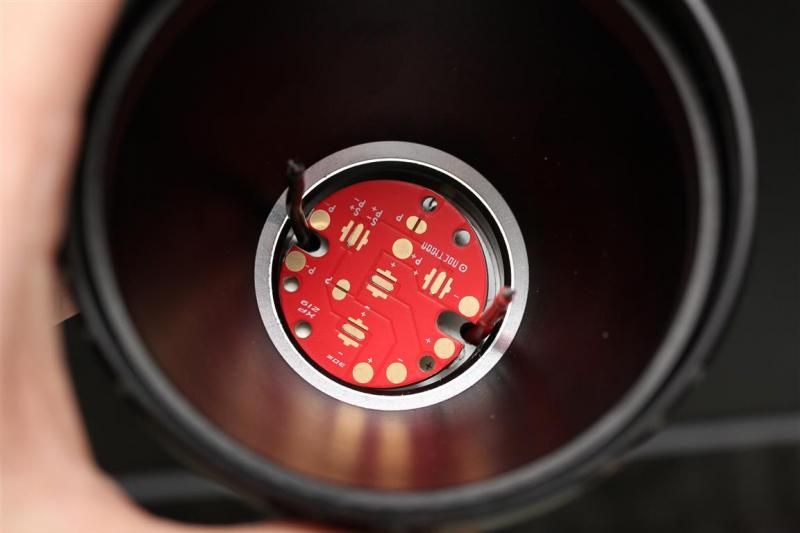
Ok, the mod... No last part of teardown first.. :p
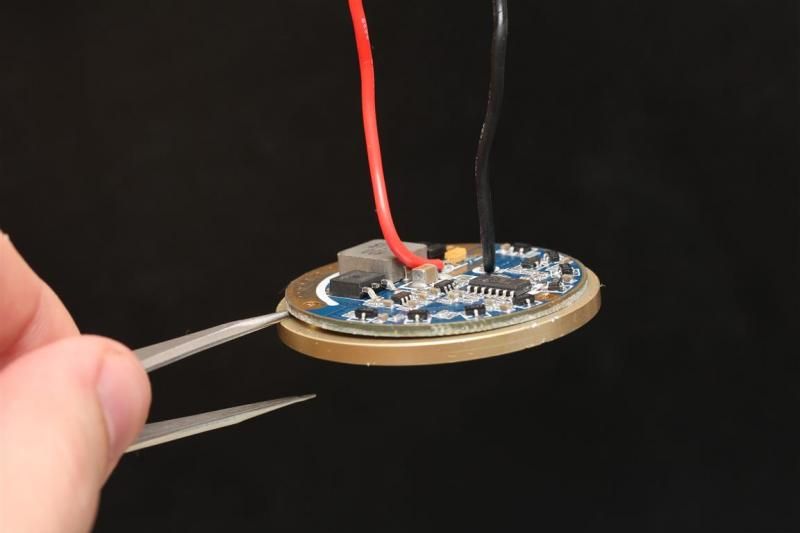
Driver was really stuck to the ring it was attached too. As you can see from the scratches. I started working my way under the driver with small flat screwdrivers from the opposite side of where the silicone stuff was. Once I was around to the area where the silicone stuff was, I used a knife to cut it away. Not too far in though. Then I put more pressure on the driver from different angels, and the spring, and it popped off with a loud sound. I did not like this process, required a good amount of force. I was afraid of breaking the driver or some components.
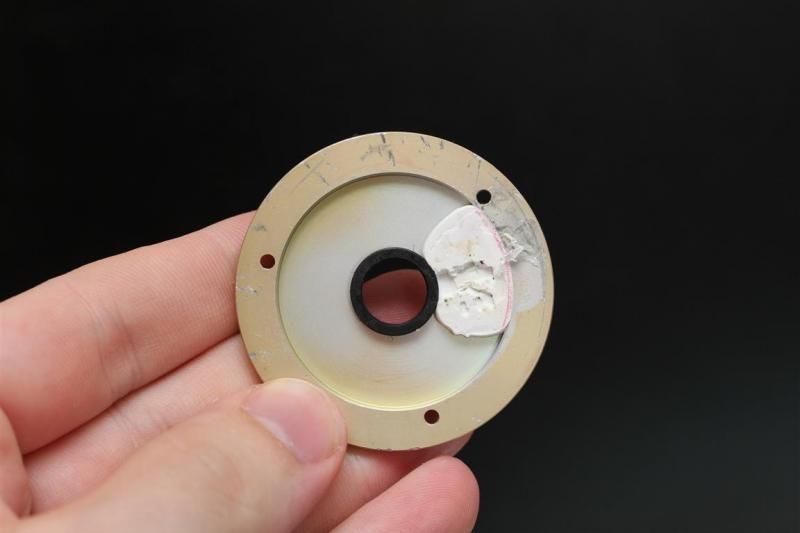
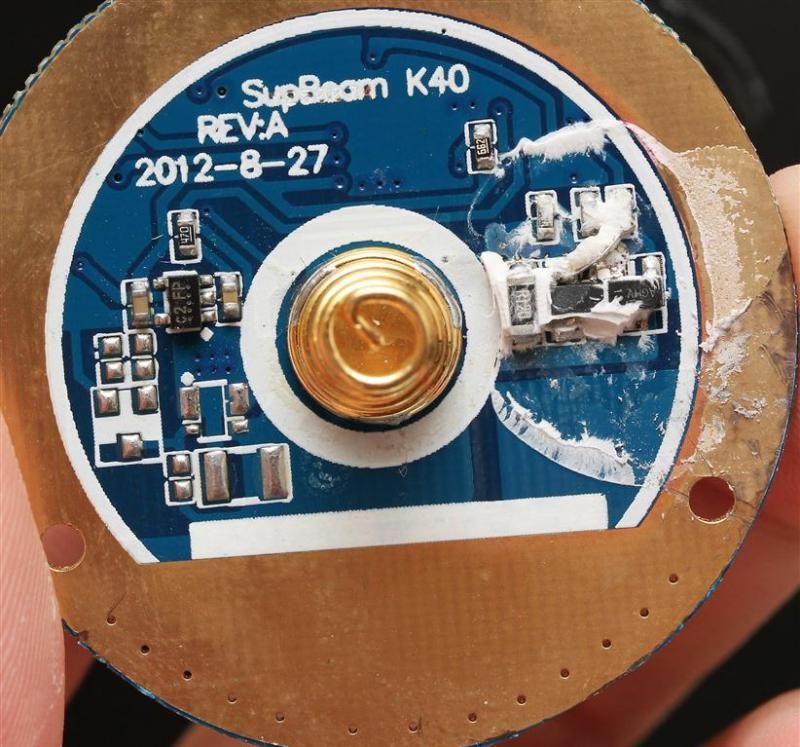
Some numbers may be off, and not that precise due to the behavior of the driver and me going a little bit by memory.
The three stock sense resistor that are stacked are R100, R120 and R120 (0,0375 total). Ideally, you do not want to have more then three in height. Because it becomes too tall. Stock setup gave around 5A at startup to the emitter at startup, and sinking a little before the power decrease.
Adding one R100 to the stock setup gave roughly 6A (0,0272 total)
Adding another R100 to the previous setup gave me roughly 7A (0,021 total)
Starting over with a combination of R100+R030+R100 gave me around 7,9A at startup. (0,0187 total)
I mostly did my testing with two different power supplies. But at this point moved over to using the flashlight and batteries.
I had tested the 7,9A (startup) with 3 XM-Ls in parallel. I then moved on to test it with an XM-L2 on Noctigon. All seemed well.
Put the driver into the light. I then did spring mod (should not matter, I used a PS before). And upgraded to 18AWG wires. Hoping to see the same result as with the Noctigon and the powersupply.
Fired it up with the stock emitter. Instant poff. Hmm. Could the wire increase have affected it? I don't know..
Tested it with the 3 XM-Ls in parallel, and it started on the same 7,9A and sank like the titanic like it usually did. I think the instantly killed emitter was a bit strange. But I was probably at the very edge when testing it before to an XM-L2 before I tested it in the light.
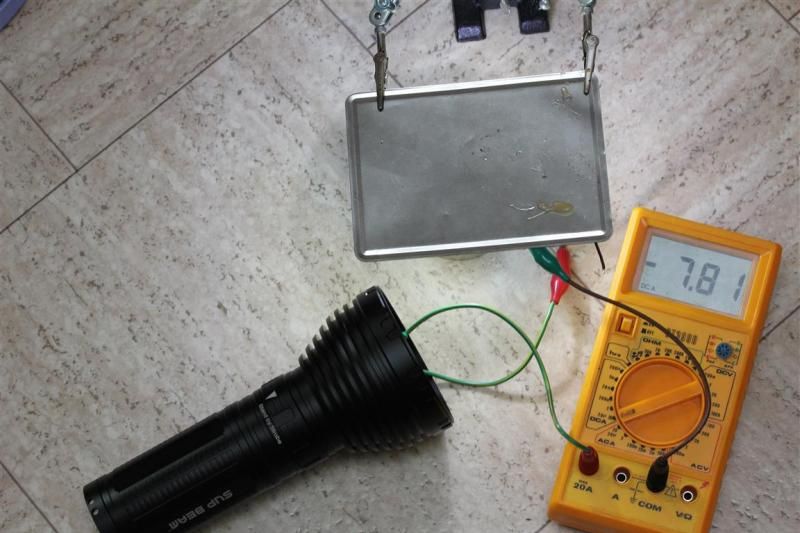
I removed one R100. (Using R100+R030 for a 0,023 total) Also reflowed a junk XM-L2 on to the stock mcpcb for testing. Verified that the stock K40 mcpcb does have direct thermal path.
That resistor combo gave me around 6,6A to the emitter. Same sinking pattern.. I also saw that it jumped down to 5,6 after some time.. I was worried about the behavior in general. (I had forgotten that it cuts down a bit on power a little after a minute).
I decided on a really conservative setup.
R100+R100+R100 (0,0333 total) and changed emitter once more, this time to a keeper, XM-L2 U2 2C. I was done with the high amps testing.
Startup current at 5,4-5,5. But like always, it sinks quickly. Settled around 5,1-5,2 before the power decrease.
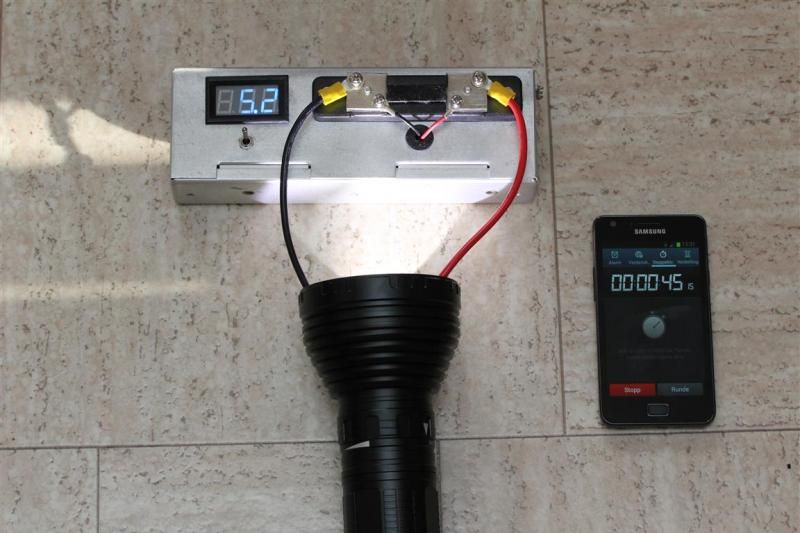
After power decrease.
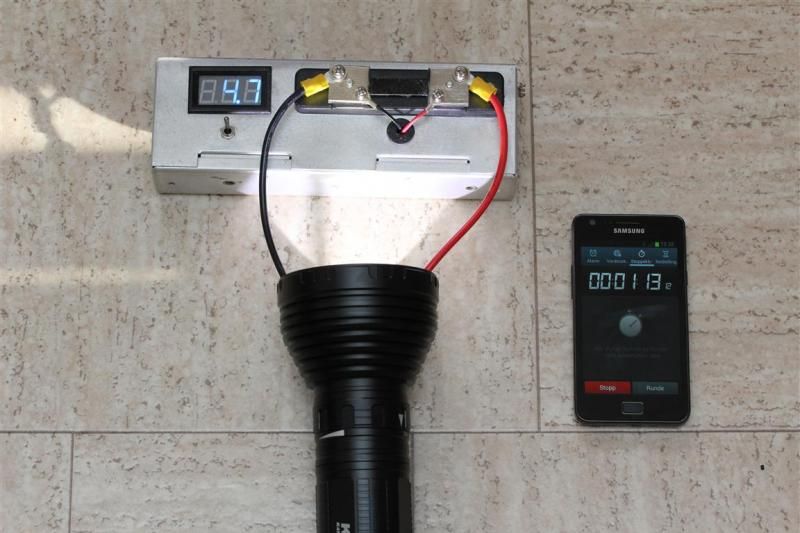
One day later. Nah. That was just too boring and low.. :D .. I know its capable of more..
Latest setup. R100+R030. Yes, that setup again. I considered to push it further, but decided to not bother due to the limited gain after some use, and the higher risk.
Once again, ill show you guys the behavior. Started at 6,9A. Drops like the titanic (check out the clock on the cell phone and the amps). Down 0,3 Amps in 5 seconds.
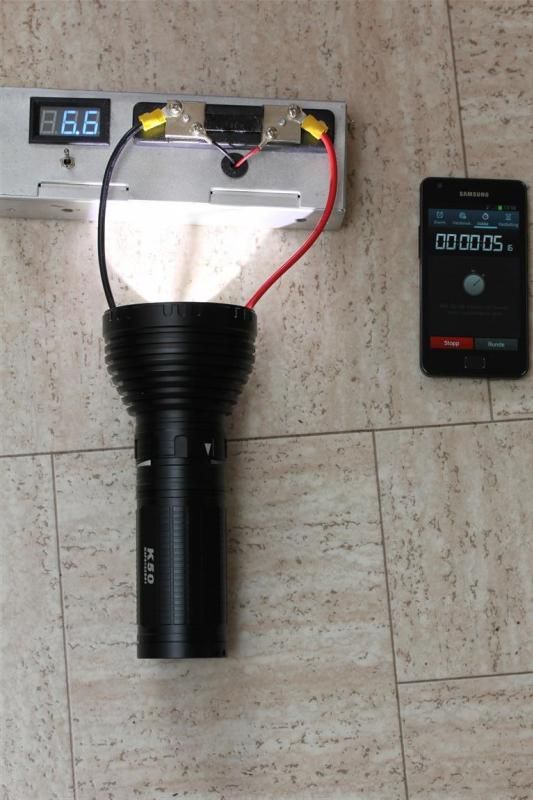
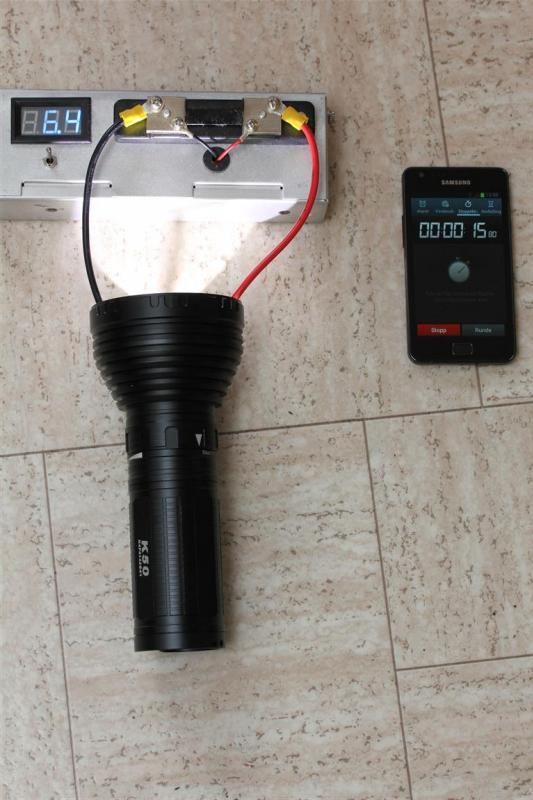
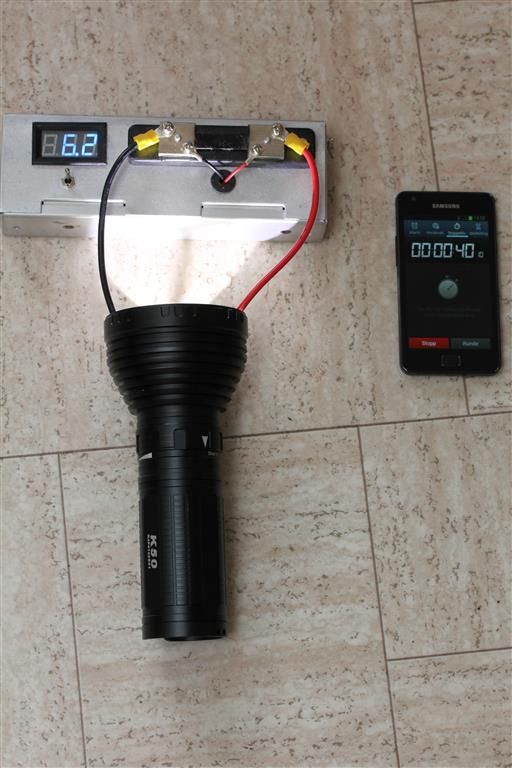
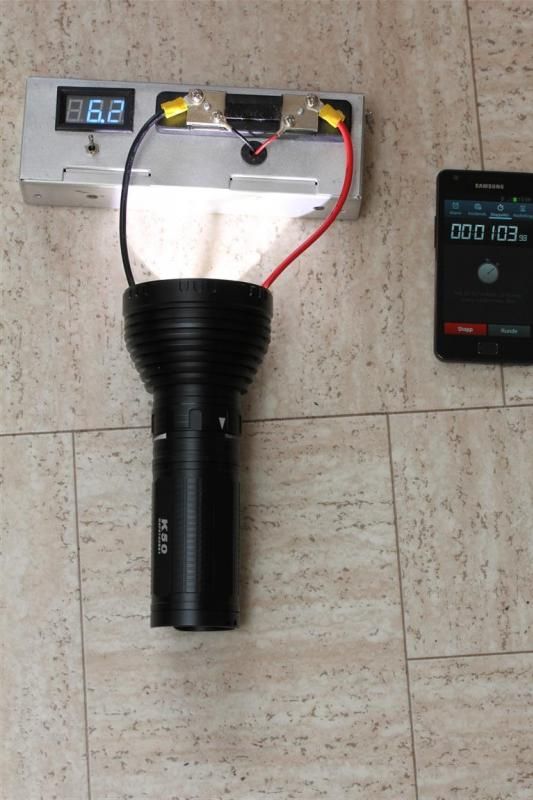
Then comes the power cut a little after a minute..

I decided to leave leave it like that. I had put already put fujick on the resistor and let it dry. I considered it done now.
Summary of behavior:
This driver can easily do 8A, at startup, but it sinks like a rock. Due to its behavior it maybe have considerably more than 8A the first milliseconds at startup, and that is not healthy.
This means that if you want at least 7A (before the power decrease that happens a little after a minute), you really have to aim for 8A. Aiming for 8A is not healthy. Maybe it can do 7,5A peak at startup and work nicely and reliable. But its likely to loose close to 1 amp of power the first minute and then being reduced more when the power decrease kicks in. And the further its pushed, the more power decrease you will see too.
All this behavior means that the light is capable of giving some nice bragging numbers at startup, and at 30 seconds if you push the emitter close to what is healthy. Startup numbers mean nothing to me if power is considerably lower after 1 minute and 15 seconds. Its really not what I am expecting from a supposedly properly regulated light. And that is the thing, the further you push it, the more output you will loose in a short time, and push it too far.. Either poff, or risk decreased emitter life.
Due to that behavior, I decided to not push mine that far. Then again, all I did was playing with the resistors. Ill leave it up to others too see if any special tweaks can be done to improve the driver.
Testing the modded light.
kcd at about 30 sec: 206
Lumen: 1638 (1722 at startup)
I did some heat tests too. Ran the light for 20 minutes. After the amps have stabilized, and the power decrease have been done. I was looking at around 5,6A to the emitter and 1533 lumen.
From the point where the light have done the power decrease I checked output 10 minutes later, it had dropped less than 70 lumen. This basically means that the stock heat sink is working. When that is said. The heat is mostly around the magnetic ring. The fins on the head does not become that effective or hot compared to the magnetic ring. No surprise really.
Id say there is little point in spending time improving the heatsinking on this light. The majority of the output sag in the beginning is output sag due to how the driver works, not due to bad thermal transfer.
Other:
Dale, reflector is beefy aluminium. You will like the weight of it. :D
I lapped the pill on mine before doing all this. Used Artic siler 5.
I did not bother doing efficiency numbers.
I would be extremely careful when putting the reflector back in if you have a de-domed emitter in it.
Summary:
All in all, not the best light to mod the driver in based on my testing with the resistor mod. Then again, I often have too high expectations. Its already good as it is stock. When that is said. Output does sink a bit with its stock too, and then there is the power decrease. I never measured, but I would not be surprised if it was down to 4,5A at the emitter or lower after 1m 10sec when its stock.. Hopefully others can share some details too for a cross check.
Happy modding, if you still want to mod it...
Sorry about the long post..
Edit: Corrected some lumen numbers, and removed some info about the U2 2C.
Wow - very useful info!! Shame it's a bit flaky at high amps. Not sure if we can find out if this is what others are/were seeing. vinh obviously has the most experience and his customers generally aren't that savvy to measure these things as precisely, or at all. I calculated the max throw is in the 640 kcd area, based on 7.0A-7.5A with perfect focusing, and funnny this is what vinh, I believe, reported. I've seen big variations in kcd measurements made at different distances by rdrfronty, so that must be taken into account.
I would think the TN32 would have the same issues since they seem to have the same K40/TN31 driver with the same "stock mod".
Excellent info. Thank you RaceR86.
Sounds like that "stock" mod is for the birds. In the end, it appears that the driver doesn't do much better than the unmodded driver (TN31, with resister bank shorted) other than for the first minute. I rather have more stable output.
Vinh`s (latest??) K50 is specified to run in the 6-7A range. With the behavior I have seen Im not surprised to see that he is specifying that range, and not a specific number.
If he have just done a resistor mod, im guessing the light is mostly likely doing up towards 7,5A at startup and sinking below 7A before the power decrease (mine is 6,9, or more like 6,6-6,2A depending on how you look at it).
Use ANSI calibrated measuring device, and measure at 1min 15 sec instead of 30 seconds and there will not be that much difference between the different resistor mods that started in the 6,2-7,5A range. Certainly not anything visually.
Im quite confident that Im running a reliable setup. 20 minute runtime test. Extremely hot light, uncomfortable to hold. No issues.
ImA4Wheelr, I certainly got an amp increase out of it after the 1 min 10 second mark too. But not as much as I had hoped for. My lumen and kcd numbers would have been better with an XM-L2 U2 1A. I cant tell how it compares to the K40 /typical TN drivers when modded. Never owned one of those lights to see how they behave once they are modded.
I can add Im getting same output numbers when cells are 3,7 as when they are 4,2. So that is a good thing.
Oh, I wasn't referring to your mod. Yes, you certainly increased the current before and after the step down. I like your mod.
I just meant that compared to the older driver in the TN31, the current increase isn't enough for me to have to tolerate a less stable output situation.
EDIT: next time I'm in my TN31, I will need to check for this step down you discovered. I didn't measure current for that long when I was working on it.
Is the TN31 dead stable on the output?
Maybe RMM`s latest trick for the HX-1175B will work on the K50?
Ive got a suitable part, but Ill leave the K50 as it is for now. Got some other interesting projects.. ^^
Tom E is probably a better judge of that as I think he has done x number of TN31's.
My one TN31 seemed to give me an oscillating type reading, but it centered around some where under 6 amps. It didn't drop while testing. I didn't measure current long enough to know if it stepped down at 1min10secs.
Can a sink be added to the FET’s? Would that help with that falling amperage issue?
I do like the idea of a beefy aluminum reflector. I like to file a bevel to the base so that it’s narrow around the emitter, giving clearance to the wires. I have that same big Noctigon on the way, is the central pad linked to lead pads towards the outer edge or just exactly where are those?
Thanks a bunch for those results and the various testing, spot on with what we are looking to know! ![]()
Not sure if I understand the Noctigon XP32 question.
You can pretty much see all traces and everything here:

Edit:
I might have some issues with my light. Not sure what, but ive damaged the stock carrier springs. Was doing tests with low voltage batteries (3,3V) Same issues with improved springs... Light works nicely with cells with higher voltage. Too tired to do more testing today...
Light perform nicely outdoors. Beam was just as expected based on beamshots I have seen.
Thanks for the work so far, RaceR86.
My K50 arrived today (from HKE, as I missed out on the GB). Ordered on the evening of the 17th, delivered today, 29th. Not bad for standard shipping to AU.
Initial thoughts/observations;
Came with the full kit, same as in the GB, warranty card, etc., & also an AU mains adapter thrown in.
The adjusting ring does have a slight color mismatch. Of course, this was the first thing I looked for, with all the hoo-ha going on. I had to look hard to see the difference, & I probably would not have noticed if it hadn't been a hot subject atm.
Battery carrier is really set up for protected/long cells - my laptop pulls with solder-blob on top were a fairly loose fit.
Stock performance is pretty impressive (which you would expect from a high-end light).
The reflector seems to have a extremely light OP finish, definitely not mirror-smooth.
Overall, I'm pleased - this is the most expensive light I've purchased.
Unless I'm mistaken, there's no reason to fit the Noctigon XP32, unless you want to change to XP-G2 (or XP-L), as the stock plate is direct-to-copper.
I think I'll run with a de-domed XM-L2, as it's a pretty tight spot already, & amp-boost. I'm eagerly awaiting for more info on the driver, to see if that initial sag can be overcome. :beer:
-edit - also, how do you find the spring arrangement in the tail of the light - seems a little convoluted to me... plenty of springs to have to resistance-mod in there...
-edit #2 - Stock throw reading taken @ ~10m; right on 200kcd. (~894 meters).
somebody try replace with one xpg2 ?
FmC. I believe negative goes out the center spring at the back of the battery carrier. The other two springs are used for other stuff. There is a lot of electronics in the battery carrier, and some in the tail. Its beyond me. Ill post pictures tomorrow.
Im not sure the battery carrier is up for the amps that you get on a modded light when its running with low voltage cells.
May not be smart to mod the light... Not because of the driver, but because of the electronics in the battery carrier.
Can someone check on the stock light if the bottom of battery carrier becomes hot of you use some (panasonic) cells at around 3,3V on max setting for a minute or two?
I can test with Samsung ICR18650-28A’s unprotected. Won’t be until about this time tomorrow, though.
Ok - I decided to stay up & have a few ![]() ’s , & discharged some of my Samsung ICR18650-28A’s down to 3.30 - 3.34v.
’s , & discharged some of my Samsung ICR18650-28A’s down to 3.30 - 3.34v.
Tested in the K50 for a little over 2 mins on high.
Externally, no noticeable difference in heat.
Took the carrier out, & noted that the end was slightly warm. Not hot. But warmer than the rest of the carrier.
I had to put it up to my cheek to get a better idea of the temp difference, as my fingers are pretty heat-tolerant due to my work.
The battery indicator light was flashing red when I started the test, & I noticed that it had gone out completely when I switched it off.
Thanks FmC. That is nice to know. Cheers mate!
My full update below:
Ive had no issues with the driver. With my resistor mod, input amps is 2,7A @ 12V and 2,9A @11V (11v divided on 4 cells means 2,75v on on load) when tested with a powersupply (should roughly give efficiency around 80% or a bit lower). I did not think up towards 3A should be an issue for the springs in the carrier.. Yet, when I did some startups with some unprotected NCR18650PF cells at around 3,3V there were some issues. It started with full output, but very quickly showed some strange behavior with the output. I took out the carrier and the bottom of it was burning hot.
Springs had "sagged" a bit. Typical issue if they are seeing too many amps.
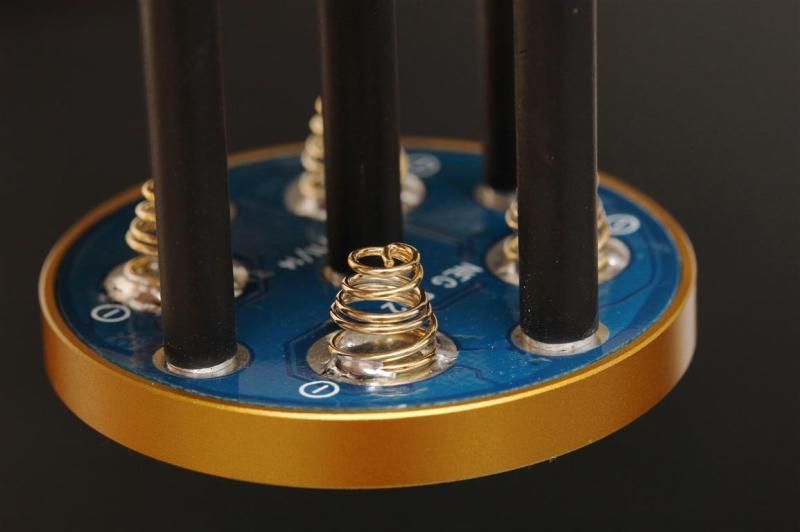
I replaced the springs and added some 22awg wire too them. Tested again. Battery carrier got really hot in a short time.
Top of the carrier is easy to disassemble. Nothing to see there. The bottom end is not supposed to be opened. I used a hot air gun on the stuff that was inside the screws in order to screw them out. Here is the battery carrier bottom side.

Notice component at the far right. Not sure about the component at the far left.
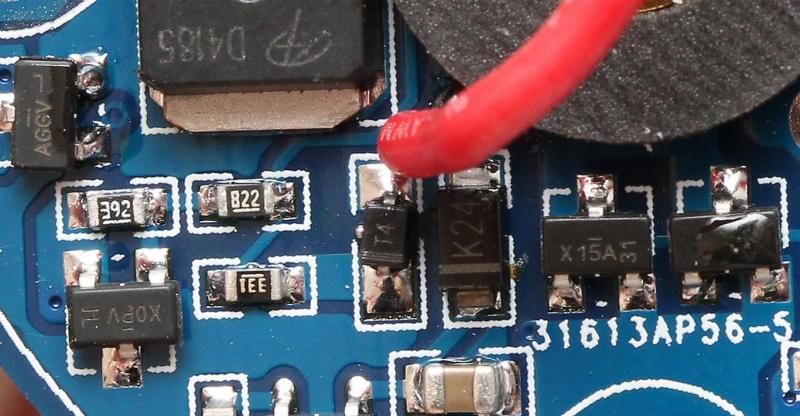
Here is a picture of the electronics in the tail:
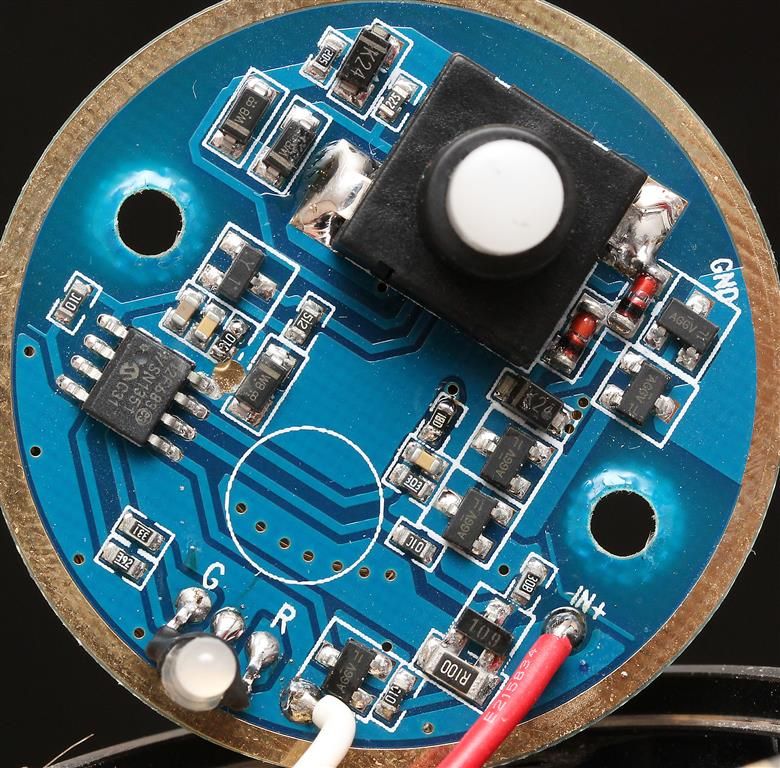
Not sure what do do know. Sup/Acebeam can sell me a new carrier. Price is not bad considering all the components on it. (20$ + a little bit in shipping)
Im considering to just get a new carrier instead of trying to replace parts in mine that may be broken or damaged. And then just mod the driver back to stock....
My light works nicely otherwise. Ive been using it outdoors a bit the last two nights. Taking it for a walk and comparing with other lights. But im not a fan of a light that seems to have issues with low voltage cells. Im not a fan of using the built in charging system when Ive got some components that look like they do.
I wonder if the electronics in the battery carrier is not up for the task of increased amps when cells get low, which naturally increases amps more in a regulated light like this.
Electronics gurus, feel free to share some insight and knowledge.
